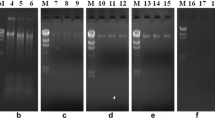Abstract
A challenge of metagenomic studies is in the extraction and purification of DNA from environmental samples. The soils of the Cerrado region of Brazil present several technical difficulties to DNA extraction: high clay content (>55% w/w), low pH (4.7) and high iron levels (146 ppm). Here we describe for the first time the efficient recovery and purification of microbial DNA associated with these unusual soil characteristics and the construction and validation of two metagenomic libraries: a 150,000 clones library with insert size of approximately 8 kb and a 65,000 clones library with insert size of approximately 35 kb. The construction of these metagenomic libraries will allow the biotechnological exploitation of the microbial community present in the soil from this endangered biome.


Similar content being viewed by others
References
Aremu MO, Atolaiye BO, Labaran L (2010) Environmental implication of metal concentrations in soil, plant foods and pond in area around the derelict udege mines of Nasarawa states, Nigeria. Bull Chem Soc Ethiop 24:351–360
Borneman J, Skroch PW, O’Sullivan KM, Palus JA, Rumjanek NG, Jansen JL, Nienhuis J, Triplett EW (1996) Molecular microbial diversity of an agricultural soil in Wisconsin. Appl Environ Microbiol 62:1935–1943
Brady N, Weil RR (2002) The nature and properties of soils, 13th edn. Pearson education, Inc, Upper Saddler River, New Jersey
Davis JA (1984) Complexation of trace metals by adsorbed natural organic matter. Geochim Cosmochim Acta 48:679–691
Dubinsky EA, Silver WL, Firestone MK (2010) Tropical forest soil microbial communities couple iron and carbon biogeochemistry. Ecology 91:2604–2612
Gillespie DE, Brady SF, Bettermann AD, Cianciotto NP, Liles MR, Rondon MR, Clardy J, Goodman RM, Handelsman J (2002) Isolation of antibiotics turbomycin and B from a metagenomic library of soil microbial DNA. Appl Environ Microbiol 68:4301–4306
Griffiths RI, Whiteley AS, O’Donnell AG, Bailey MJ (2000) Rapid method for coextraction of DNA and RNA from natural environments for analysis of ribosomal DNA- and rRNA-based microbial community composition. Appl Environ Microbiol 66:5488–5491
Harrison PM, Arosio P (1996) The ferritins: molecular properties, iron storage function and cellular regulation. Biochim Biophys Acta 1275:161–203
He J, Xua Z, Hughes J (2005) Pre-lysis washing improves DNA extraction from a forest soil. Soil Biol Biochem 37:2337–2341
Huber T, Faulkner G, Hugenholtz P (2004) Bellerophon: a program to detect chimeric sequences in multiple sequence alignments. Bioinformatics 20:2317–2319
Janssen PH (2006) Identifying the dominant soil bacterial taxa in libraries of 16S rRNA geneand 16S rRNA genegenes. Appl Environ Microbiol 72:1719–1728
Jenne EA (1988) In: Baker, RA (ed) Trace inorganics in water. Advance Chemical Series, vol 73. Johnson Books, Boulder
Krsek M, Wellington EM (1999) Comparison of different methods for the isolation and purification of total community DNA from soil. J Microbiol Methods 39:1–16
Newman JR, Fuqua C (1999) Broad-host-range expression vectors that carry the l-arabinose-inducible Escherichia coli araBAD promoter and the araC regulator. Gene 227:197–203
O’Neill B, Grossman J, Tsai MT, Gomes JE, Lehmann J, Peterson J, Neves E, Thies JE (2009) Bacterial community composition in Brazilian anthrosols and adjacent soils characterized using culturing and molecular identification. Microb Ecol 58:23–35
Purdy KJ (2005) Nucleic acid recovery from complex environmental samples. Methods Enzymol 397:271–292
Rapp MS, Giovannoni SJ (2003) The uncultured microbial majority. Annu Rev Microbiol 57:369–394
Sagova-Mareckova ML, Cermak L, Novotna J, Plhackova K, Forstova J, Kopecky J (2008) Innovative methods for soil DNA purification tested in soils with widely differing characteristics. Appl Environ Microbiol 74:2902–2907
Tamura K, Dudley J, Nei M, Kumar S (2007) MEGA4: Molecular Evolutionary Genetics Analysis (MEGA) software version 4.0. Mol Biol Evol 24:1596–1599
Williamson LL, Borlee BR, Schloss PD, Guan C, Allen HK, Handelsman J (2005) Intracellular screen to identify metagenomic clones that induce or inhibit a quorum-sensing biosensor. Appl Environ Microbiol 71:6335–6344
Acknowledgment
This work was supported by grants from FAPDF and CNPq.
Author information
Authors and Affiliations
Corresponding author
Electronic supplementary material
Below is the link to the electronic supplementary material.
10529_2011_693_MOESM1_ESM.eps
Supplementary Table 1 Classification of end sequenced clones from the low copy number plasmid and fosmid metagenomic library. Plasmid and fosmid DNA were isolated by using QIAprep Miniprep (QIagen) and sequenced with forward pCF430 primer and reverse pCF430 primer to low copy number plasmid. The fosmid ends were sequenced with PCC1FOS forward primer and PCC1FOS reverse primer. The high quality sequences of both libraries were submitted to search for homology in public databases using BLASTx. (EPS 2073 kb)
10529_2011_693_MOESM2_ESM.eps
Supplementary Fig. 1. Map of Brazil showing the localization of the Cerrado biome and how it has been reduced. a Original area covered with Cerrado vegetation and b Current area covered with Cerrado vegetation. Map of Brazil-Conservation International 2008 (http://www.conservation.org.br/). (EPS 693 kb)
Rights and permissions
About this article
Cite this article
de Castro, A.P., Quirino, B.F., Allen, H. et al. Construction and validation of two metagenomic DNA libraries from Cerrado soil with high clay content. Biotechnol Lett 33, 2169–2175 (2011). https://doi.org/10.1007/s10529-011-0693-6
Received:
Accepted:
Published:
Issue Date:
DOI: https://doi.org/10.1007/s10529-011-0693-6




